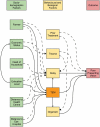Epidemiology of Microbial Keratitis in Uganda: A Cohort Study
- PMID: 31830848
- PMCID: PMC7446037
- DOI: 10.1080/09286586.2019.1700533
Epidemiology of Microbial Keratitis in Uganda: A Cohort Study
Abstract
Purpose: To describe the epidemiology of Microbial Keratitis (MK) in Uganda.Methods: We prospectively recruited patients presenting with MK at two main eye units in Southern Uganda between December 2016 and March 2018. We collected information on clinical history and presentation, microbiology and 3-month outcomes. Poor vision was defined as vision < 6/60).Results: 313 individuals were enrolled. Median age was 47 years (range 18-96) and 174 (56%) were male. Median presentation time was 17 days from onset (IQR 8-32). Trauma was reported by 29% and use of Traditional Eye Medicine by 60%. Majority presented with severe infections (median infiltrate size 5.2 mm); 47% were blind in the affected eye (vision < 3/60). Microbiology was available from 270 cases: 62% were fungal, 7% mixed (bacterial and fungal), 7% bacterial and 24% no organism detected. At 3 months, 30% of the participants were blind in the affected eye, while 9% had lost their eye from the infection. Delayed presentation (overall p = .007) and prior use of Traditional Eye Medicine (aOR 1.58 [95% CI 1.04-2.42], p = .033) were responsible for poor presentation. Predictors of poor vision at 3 months were: baseline vision (aOR 2.98 [95%CI 2.12-4.19], p < .0001), infiltrate size (aOR 1.19 [95%CI 1.03-1.36], p < .020) and perforation at presentation (aOR 9.93 [95% CI 3.70-26.6], p < .0001).Conclusion: The most important outcome predictor was the state of the eye at presentation, facilitated by prior use of Traditional Eye Medicine and delayed presentation. In order to improve outcomes, we need effective early interventions.
Keywords: Microbial keratitis; Uganda; bacterial keratitis; blindness; fungal keratitis; keratitis.
Figures



References
-
- Bennett JE, Dolin R, Blaser MJ.. Mandell, Douglas, and Bennett’s Principles and Practice of Infectious Diseases E-Book. Elsevier Health Sciences; 2014, New York, USA.
Publication types
MeSH terms
Substances
Grants and funding
LinkOut - more resources
Full Text Sources
Other Literature Sources
Medical
